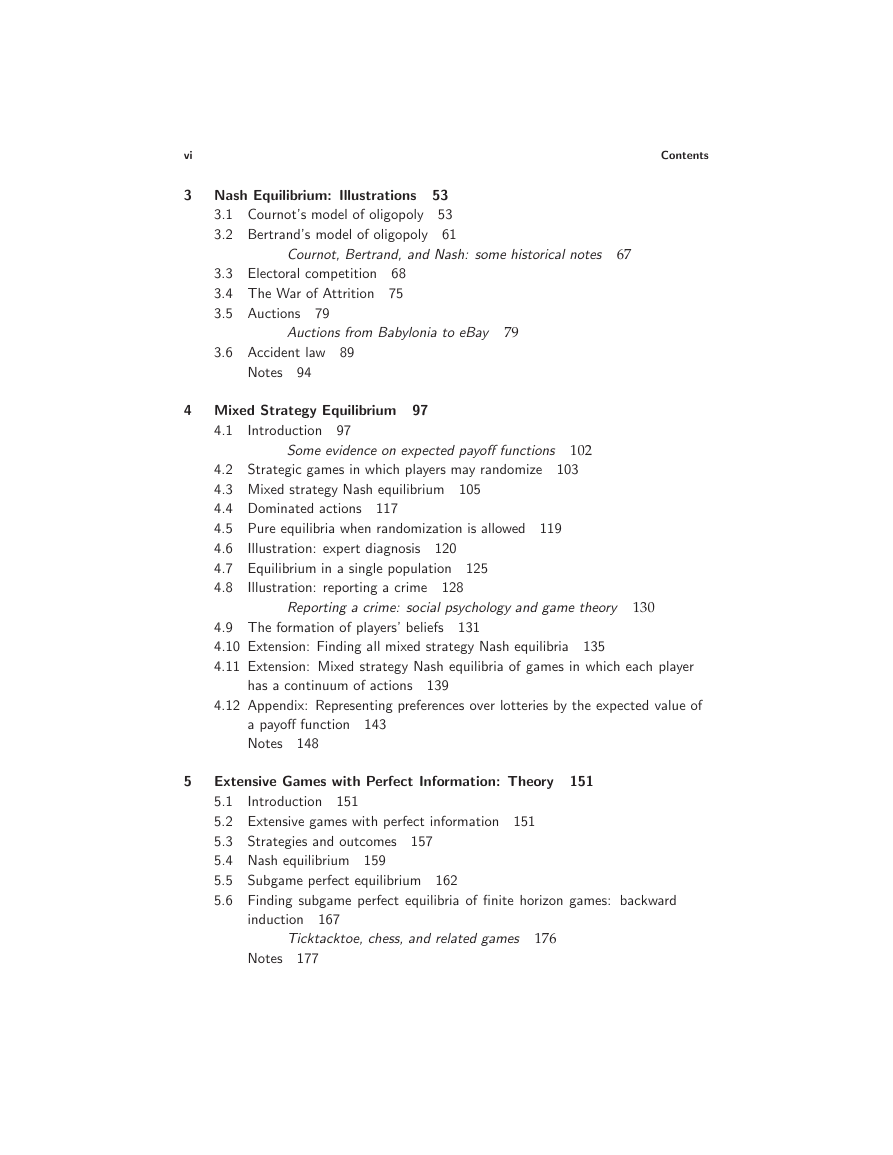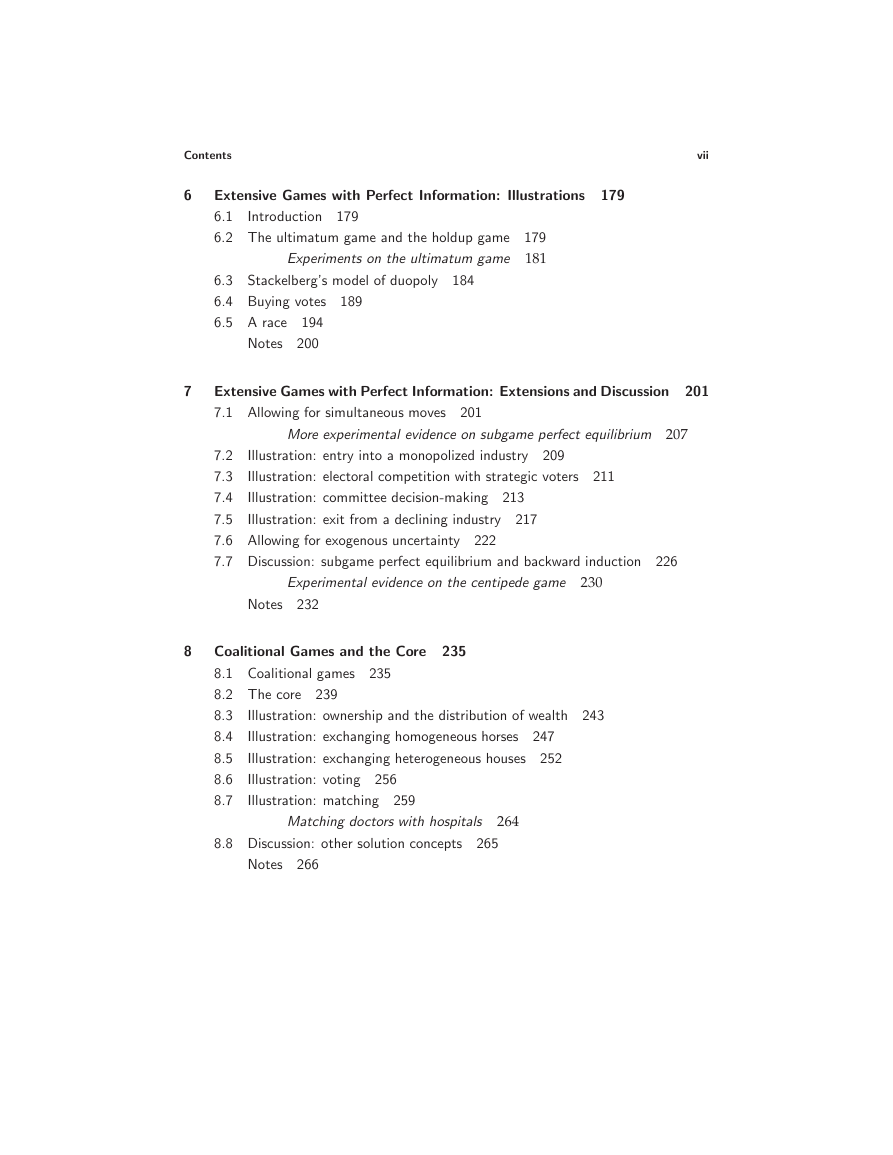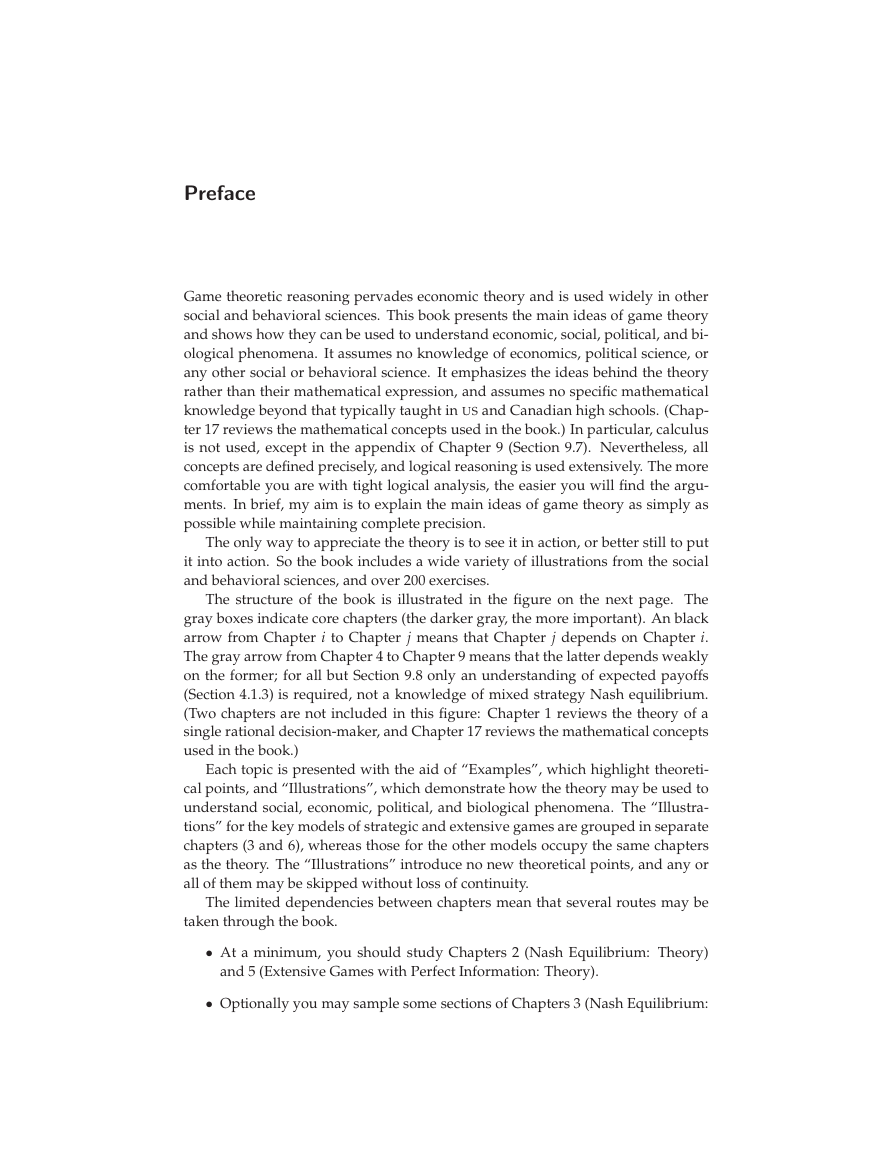Copyright c 1995–2000 by Martin J. Osborne
All rights reserved. No part of this book may be reproduced by any electronic or mechanical means
(including photocopying, recording, or information storage and retrieval) without permission in
writing from Oxford University Press.
�
Contents
Preface
xiii
1
Introduction 1
1.1 What is game theory? 1
An outline of the history of game theory
John von Neumann 3
3
1.2 The theory of rational choice 4
1.3 Coming attractions 7
Notes 8
I Games with Perfect Information 9
2 Nash Equilibrium: Theory 11
11
2.1 Strategic games
2.2 Example: the Prisoner’s Dilemma
2.3 Example: Bach or Stravinsky? 16
2.4 Example: Matching Pennies 17
2.5 Example: the Stag Hunt
2.6 Nash equilibrium 19
18
12
John F. Nash, Jr.
Studying Nash equilibrium experimentally
20
22
2.7 Examples of Nash equilibrium 24
Experimental evidence on the Prisoner’s Dilemma
Focal points
30
26
2.8 Best response functions 33
2.9 Dominated actions 43
2.10 Equilibrium in a single population: symmetric games and symmetric
equilibria 49
Notes 51
v
�
vi
Contents
3 Nash Equilibrium: Illustrations 53
3.1 Cournot’s model of oligopoly 53
3.2 Bertrand’s model of oligopoly 61
Cournot, Bertrand, and Nash: some historical notes
67
3.3 Electoral competition 68
3.4 The War of Attrition 75
3.5 Auctions
79
Auctions from Babylonia to eBay
79
3.6 Accident law 89
Notes 94
4 Mixed Strategy Equilibrium 97
4.1
Introduction 97
Some evidence on expected payoff functions
102
4.2 Strategic games in which players may randomize 103
4.3 Mixed strategy Nash equilibrium 105
4.4 Dominated actions 117
4.5 Pure equilibria when randomization is allowed 119
4.6
4.7 Equilibrium in a single population 125
4.8
Illustration: expert diagnosis 120
Illustration: reporting a crime
128
Reporting a crime: social psychology and game theory
130
4.9 The formation of players’ beliefs
4.10 Extension: Finding all mixed strategy Nash equilibria 135
4.11 Extension: Mixed strategy Nash equilibria of games in which each player
131
has a continuum of actions 139
4.12 Appendix: Representing preferences over lotteries by the expected value of
a payoff function 143
Notes 148
5
Introduction 151
Extensive Games with Perfect Information: Theory
5.1
5.2 Extensive games with perfect information 151
5.3 Strategies and outcomes 157
5.4 Nash equilibrium 159
5.5 Subgame perfect equilibrium 162
5.6 Finding subgame perfect equilibria of finite horizon games: backward
151
induction 167
Ticktacktoe, chess, and related games
176
Notes 177
�
Contents
vii
6
Introduction 179
Extensive Games with Perfect Information: Illustrations 179
6.1
6.2 The ultimatum game and the holdup game 179
181
Experiments on the ultimatum game
6.3 Stackelberg’s model of duopoly 184
6.4 Buying votes 189
6.5 A race
194
Notes 200
7
Extensive Games with Perfect Information: Extensions and Discussion 201
7.1 Allowing for simultaneous moves 201
More experimental evidence on subgame perfect equilibrium 207
Illustration: entry into a monopolized industry 209
Illustration: electoral competition with strategic voters
Illustration: committee decision-making 213
Illustration: exit from a declining industry 217
7.2
7.3
7.4
7.5
7.6 Allowing for exogenous uncertainty 222
7.7 Discussion: subgame perfect equilibrium and backward induction 226
211
Experimental evidence on the centipede game
230
Notes 232
8
239
235
Coalitional Games and the Core
8.1 Coalitional games 235
8.2 The core
8.3
8.4
8.5
8.6
8.7
Illustration: ownership and the distribution of wealth 243
Illustration: exchanging homogeneous horses 247
Illustration: exchanging heterogeneous houses 252
Illustration: voting 256
Illustration: matching 259
Matching doctors with hospitals
264
8.8 Discussion: other solution concepts 265
Notes 266
�
viii
Contents
II Games with Imperfect Information 269
9
Bayesian Games 271
9.1
Introduction 271
9.2 Motivational examples
9.3 General definitions 276
9.4 Two examples concerning information 281
9.5
9.6
9.7
271
Illustration: Cournot’s duopoly game with imperfect information 283
Illustration: providing a public good 287
Illustration: auctions 290
Auctions of the radio spectrum 298
Illustration: juries
9.8
9.9 Appendix: Analysis of auctions for an arbitrary distribution of
299
valuations 306
Notes 309
10 Extensive games with imperfect information 311
10.1 To be written 311
Notes 312
III Variants and Extensions
333
11 Strictly Competitive Games and Maxminimization 335
11.1 Introduction 335
11.2 Definitions and examples
11.3 Strictly competitive games 338
335
Maxminimization: some history
Testing the theory of Nash equilibrium in strictly competitive
344
Notes 348
games
347
12 Rationalizability 349
12.1 Introduction 349
12.2 Iterated elimination of strictly dominated actions 355
12.3 Iterated elimination of weakly dominated actions 359
Notes 361
�
Contents
ix
13 Evolutionary Equilibrium 363
13.1 Introduction 363
13.2 Monomorphic pure strategy equilibrium 364
Evolutionary game theory: some history
369
13.3 Mixed strategies and polymorphic equilibrium 370
13.4 Asymmetric equilibria 377
Explaining the outcomes of contests in nature
379
13.5 Variation on a theme: sibling behavior 380
13.6 Variation on a theme: nesting behavior of wasps 386
Notes 388
14 Repeated games: The Prisoner’s Dilemma
389
391
14.1 The main idea 389
14.2 Preferences
14.3 Infinitely repeated games 393
14.4 Strategies
14.5 Some Nash equilibria of the infinitely repeated Prisoner’s Dilemma
14.6 Nash equilibrium payoffs of the infinitely repeated Prisoner’s Dilemma when
394
396
the players are patient
398
14.7 Subgame perfect equilibria and the one-deviation property 402
14.8 Some subgame perfect equilibria of the infinitely repeated Prisoner’s
Dilemma
Notes 409
404
15 Repeated games: General Results
411
15.1 Nash equilibria of general infinitely repeated games 411
15.2 Subgame perfect equilibria of general infinitely repeated games 414
Axelrod’s experiments
Reciprocal altruism among sticklebacks
418
419
15.3 Finitely repeated games 420
Notes 420
16 Bargaining 421
16.1 To be written 421
16.2 Repeated ultimatum game 421
16.3 Holdup game 421
�
x
Contents
17 Appendix: Mathematics 443
443
444
17.1 Introduction 443
17.2 Numbers
17.3 Sets
17.4 Functions 445
17.5 Profiles 448
17.6 Sequences
449
17.7 Probability 449
17.8 Proofs
454
References
457
�
Preface
Game theoretic reasoning pervades economic theory and is used widely in other
social and behavioral sciences. This book presents the main ideas of game theory
and shows how they can be used to understand economic, social, political, and bi-
ological phenomena. It assumes no knowledge of economics, political science, or
any other social or behavioral science. It emphasizes the ideas behind the theory
rather than their mathematical expression, and assumes no specific mathematical
knowledge beyond that typically taught in US and Canadian high schools. (Chap-
ter 17 reviews the mathematical concepts used in the book.) In particular, calculus
is not used, except in the appendix of Chapter 9 (Section 9.7). Nevertheless, all
concepts are defined precisely, and logical reasoning is used extensively. The more
comfortable you are with tight logical analysis, the easier you will find the argu-
ments. In brief, my aim is to explain the main ideas of game theory as simply as
possible while maintaining complete precision.
The only way to appreciate the theory is to see it in action, or better still to put
it into action. So the book includes a wide variety of illustrations from the social
and behavioral sciences, and over 200 exercises.
The structure of the book is illustrated in the figure on the next page. The
gray boxes indicate core chapters (the darker gray, the more important). An black
arrow from Chapter i to Chapter j means that Chapter j depends on Chapter i.
The gray arrow from Chapter 4 to Chapter 9 means that the latter depends weakly
on the former; for all but Section 9.8 only an understanding of expected payoffs
(Section 4.1.3) is required, not a knowledge of mixed strategy Nash equilibrium.
(Two chapters are not included in this figure: Chapter 1 reviews the theory of a
single rational decision-maker, and Chapter 17 reviews the mathematical concepts
used in the book.)
Each topic is presented with the aid of “Examples”, which highlight theoreti-
cal points, and “Illustrations”, which demonstrate how the theory may be used to
understand social, economic, political, and biological phenomena. The “Illustra-
tions” for the key models of strategic and extensive games are grouped in separate
chapters (3 and 6), whereas those for the other models occupy the same chapters
as the theory. The “Illustrations” introduce no new theoretical points, and any or
all of them may be skipped without loss of continuity.
The limited dependencies between chapters mean that several routes may be
taken through the book.
At a minimum, you should study Chapters 2 (Nash Equilibrium: Theory)
and 5 (Extensive Games with Perfect Information: Theory).
Optionally you may sample some sections of Chapters 3 (Nash Equilibrium:
�
















 2023年江西萍乡中考道德与法治真题及答案.doc
2023年江西萍乡中考道德与法治真题及答案.doc 2012年重庆南川中考生物真题及答案.doc
2012年重庆南川中考生物真题及答案.doc 2013年江西师范大学地理学综合及文艺理论基础考研真题.doc
2013年江西师范大学地理学综合及文艺理论基础考研真题.doc 2020年四川甘孜小升初语文真题及答案I卷.doc
2020年四川甘孜小升初语文真题及答案I卷.doc 2020年注册岩土工程师专业基础考试真题及答案.doc
2020年注册岩土工程师专业基础考试真题及答案.doc 2023-2024学年福建省厦门市九年级上学期数学月考试题及答案.doc
2023-2024学年福建省厦门市九年级上学期数学月考试题及答案.doc 2021-2022学年辽宁省沈阳市大东区九年级上学期语文期末试题及答案.doc
2021-2022学年辽宁省沈阳市大东区九年级上学期语文期末试题及答案.doc 2022-2023学年北京东城区初三第一学期物理期末试卷及答案.doc
2022-2023学年北京东城区初三第一学期物理期末试卷及答案.doc 2018上半年江西教师资格初中地理学科知识与教学能力真题及答案.doc
2018上半年江西教师资格初中地理学科知识与教学能力真题及答案.doc 2012年河北国家公务员申论考试真题及答案-省级.doc
2012年河北国家公务员申论考试真题及答案-省级.doc 2020-2021学年江苏省扬州市江都区邵樊片九年级上学期数学第一次质量检测试题及答案.doc
2020-2021学年江苏省扬州市江都区邵樊片九年级上学期数学第一次质量检测试题及答案.doc 2022下半年黑龙江教师资格证中学综合素质真题及答案.doc
2022下半年黑龙江教师资格证中学综合素质真题及答案.doc